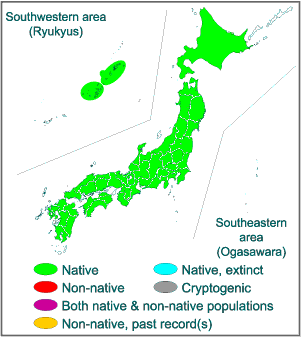
 Japanese |
English
Japanese |
English- Invasive Species of Japan >
- Vascular plants >
- Morus australis
| Invasion information | ||
| Range in Japan | Ogasawara (Bonin) Islands. (Chichijima and Hahajima Is.) |

|
| Origin | Ryukyus and Hachijojima Island, Izu Islands | |
| Date | 1890s and 1920s | |
| Route | Deliberate: For culture of silkworm | |
| Impact | Actually: Hybridization with native mulberry M. boninensis. On Chichijima and Hahajima Is., only few mother trees of the native mulberry exist, and most offspring may be hybrid. Native organism(s) affected: Native congener M. boninensis (hybridization) | |
| Regulation in Japan | Import of the fruits of Morus from the regions with Ceratitis capitata and those with Bactrocera tryoni is prohibited by the Plant Protection Law. | |
| Introduced range in other countries | Unknown. | |
| Reference | Notes |
|
Currently, this species is not used for silkworm culture. Although the invasive mulberry on Ogasawara is usually identified as M. australis in recent literature, an author pointed out that some invasive mulberries on Ogasawara seem to be M. kagayamae, the native mulberry on Hachijojima, one of the putative sources of the invasive mulberry. |